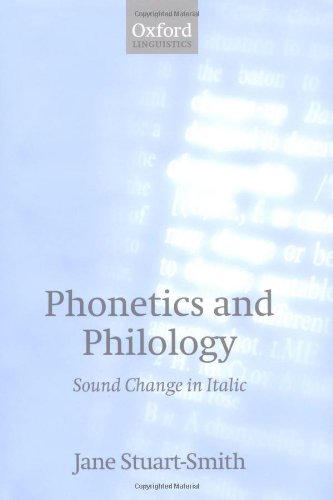

Most ebook files are in PDF format, so you can easily read them using various software such as Foxit Reader or directly on the Google Chrome browser.
Some ebook files are released by publishers in other formats such as .awz, .mobi, .epub, .fb2, etc. You may need to install specific software to read these formats on mobile/PC, such as Calibre.
Please read the tutorial at this link: https://ebookbell.com/faq
We offer FREE conversion to the popular formats you request; however, this may take some time. Therefore, right after payment, please email us, and we will try to provide the service as quickly as possible.
For some exceptional file formats or broken links (if any), please refrain from opening any disputes. Instead, email us first, and we will try to assist within a maximum of 6 hours.
EbookBell Team

4.7
16 reviews
ISBN 10: 0199257736
ISBN 13: 9780199257737
Author: Jane Stuart Smith
This book presents an exhaustive treatment of a long-standing problem of Proto-Indo-European and Italic philology: the development of the Proto-Indo-European voiced aspirates in the ancient languages of Italy. In so doing it tackles a central issue of historical linguistics: the plausibility of explanations for sound change. The author argues that the problem can be resolved by combining a traditional philological investigation with experimental phonetics. Philological methods enable the presentation of the first integrated account of the evidence for the Italic languages, with detailed discussion of languages other than Latin. Theory and methods from experimental phonetics are then adopted to offer a new explanation for how the sound change might have taken place. At the same time, phonetic methods also confirm the traditional reconstruction of voiced aspirates for Proto-Indo-European. Thus the book offers a case-study of the successful application of synchronic theory and method to a problem of diachrony.
1 Introduction: Phonetics and Philology
1.1 Philology
1.2 Phonetics
2 The Italic Sound Change: Background
2.1 The PIE voiced aspirates
2.2 The Italic development
3 Philology: The Evidence for the Italic Development
3.1 The Italic evidence
3.2 The Italic scripts and the representation of /f/
3.2.1 The digraph FH
3.2.2 F and ↑
3.2.3 Presamite
3.2.4 The origins of 8
3.3 The evidence of Latin
3.3.1 The Latin alphabet
3.3.2 Latin: The lexical evidence
3.3.3 Latin: From orthography to phonetics
3.3.4 The development of the PIE voiced aspirates in Latin
3.4 The evidence of Faliscan
3.4.1 The writing systems of Faliscan
3.4.2 Faliscan: The lexical evidence
3.4.3 Faliscan: from orthography to phonetics
3.4.4 The development of the PIE voiced aspirates in Faliscan
3.5 The evidence of the early Sabellic inscriptions
3.5.1 South Picene
3.5.2 Presamnite
3.5.3 Old Umbrian
3.5.4 Old Volscian
3.5.5 Old Hernican
3.5.6 The development of the PIE voiced aspirates in the early Sabellic inscriptions
3.6 The evidence of Oscan
3.6.1 The writing systems of Oscan
3.6.2 Oscan: The lexical evidence
3.6.3 Oscan : From orthography to phonetics
3.6.4 The development of the PIE voiced aspirates in Oscan
3.7 The evidence of Umbrian
3.7.1 The writing systems of Umbrian
3.7.2 Umbrian: The lexical evidence
3.7.3 Umbrian: From orthography to phonetics
3.7.4 The development of the PIE voiced aspirates in Umbrian
3.8 The evidence of the Minor Dialects
3.8.1 Paelignian
3.8.2 Marrucinian
3.8.3 Vestinian
3.8.4 Sabine
3.8.5 Aequian
3.8.6 Marsian
3.8.7 Hernican
3.8.8 Volscian
3.8.9 The development of the PIE voiced aspirates in the Minor Dialects
3.9 External evidence
3.9.1 The evidence of Etruscan
3.9.2 The evidence of Greek
3.9.3 External evidence: Summary
3.10 The Italic reflexes: Summary
4 The Traditional Arguments Reviewed
4.1 The traditional arguments—internal
4.1.1 The Italic reflexes
4.1.2 Loanwords
4.1.3 Conditioned changes
4.1.4 The treatment of PIE [sup(*)]-s-
4.2 The traditional arguments—external
4.2.1 Phonetic plausibility
4.2.2 Miscellaneous arguments
4.3 Summary and conclusions
5 Phonetics, Predictions, Parallels
5.1 Phonetics and predictions: The phonetics of 'voiced aspirates'
5.1.1 Breathy voiced stops: Phonation
5.1.2 Breathy voiced stops: Articulation
5.1.3 Breathy voiced stops: Aerodynamic factors
5.1.4 Breathy voiced stops: Acoustics
5.1.5 Breathy voiced stops: Perceptual cues
5.1.6 Breathy voiced stops: Stress
5.1.7 Breathy voiced stops: Word position
5.1.8 Breathy voiced stops: Place of articulation
5.1.9 Breathy voiced stops: Vocalic environment
5.1.10 The phonetics of breathy voiced stops: Predictions for change
5.2 Parallels: The diachronic behaviour of voiced aspirates
5.2.1 Attested parallels: Voiced aspirates from Old Indo-Aryan into New Indo-Aryan
5.2.2 Attested parallels: The New Indo-Aryan languages
5.2.3 Attested parallels and phonetic predictions
5.2.4 Reconstructed parallels: The PIE voiced aspirates
5.2.5 Reconstructed parallels and phonetic predictions
5.3 Phonetics, predictions, and parallels
6 A Phonetic Explanation for the Italic Development
6.1 Ascoli and Rix reviewed
6.2 A phonetic explanation for the Italic development
6.2.1 Word-initial position: for example [sup(*)][bh-] > [sup(*)][p[sup(h)]-] > [f-]
6.2.2 Word-internal position: [sup(*)][-bh-] > [-β-] (>Lat. [-b-])
6.2.3 Specific changes for the labial voiced aspirate
6.2.4 Specific changes for the dental/alveolar voiced aspirate
6.2.5 Specific changes for the velar voiced aspirate
6.2.6 Specific changes for the labiovelar voiced aspirate
6.2.7 Conditioned changes
6.2.8 The role of word-stress in the Italic development
6.2.9 The Italic development as a system
7 Concluding Remarks
q phonetic sound
the phonetics alphabet
is phonology and phonetics the same
s phonetics
mst in linguistics philology and phonetics advanced study
phonetics science
phonetics for speech pathology
Tags: Jane Stuart Smith, Phonetics, Philology